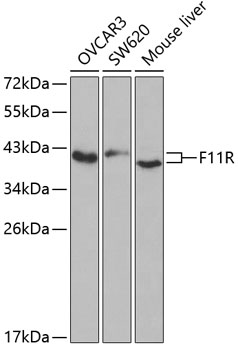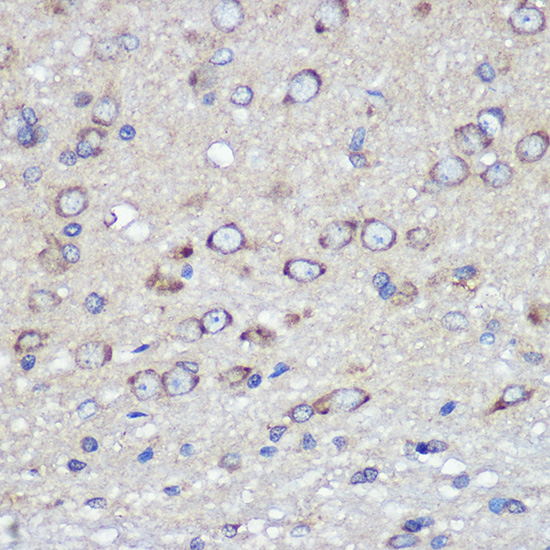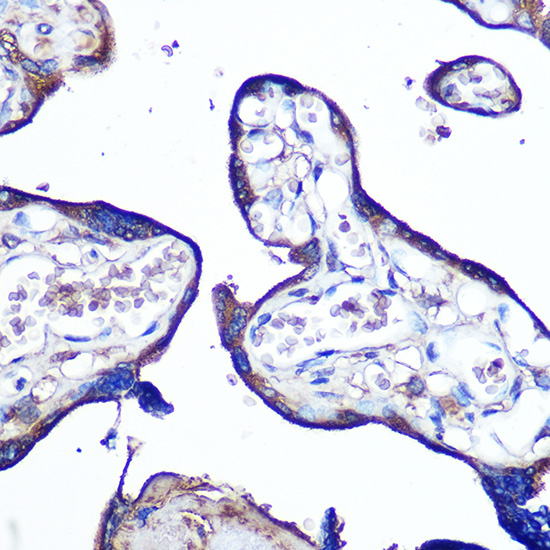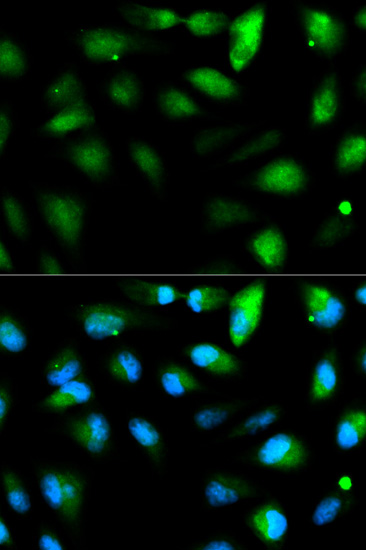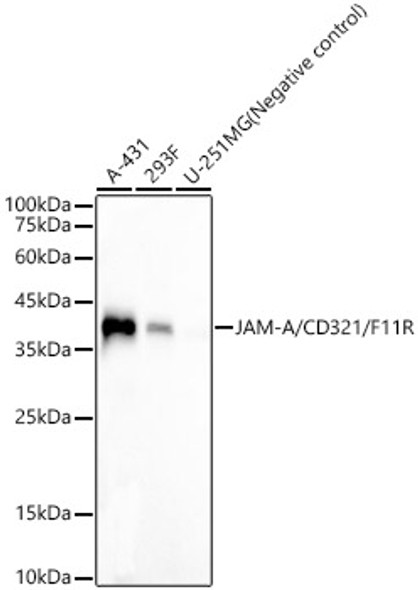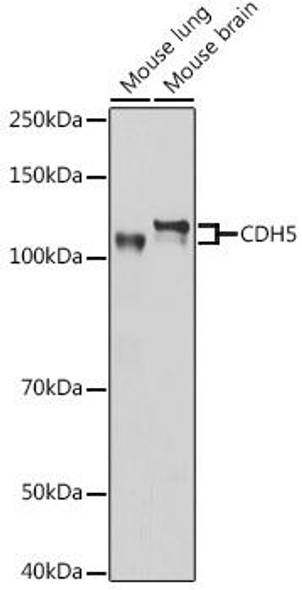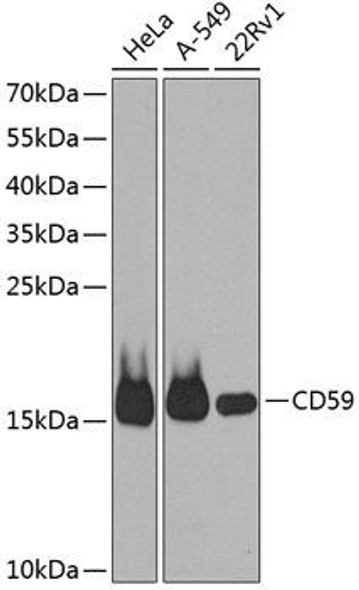Immunology Antibodies 1
Anti-F11R Antibody (CAB1241)
- SKU:
- CAB1241
- Product Type:
- Antibody
- Reactivity:
- Human
- Reactivity:
- Mouse
- Reactivity:
- Rat
- Host Species:
- Rabbit
- Isotype:
- IgG
- Antibody Type:
- Polyclonal Antibody
- Research Area:
- Immunology
Description
| Antibody Name: | Anti-F11R Antibody |
| Antibody SKU: | CAB1241 |
| Antibody Size: | 20uL, 50uL, 100uL |
| Application: | WB IHC IF |
| Reactivity: | Human, Mouse, Rat |
| Host Species: | Rabbit |
| Immunogen: | Recombinant fusion protein containing a sequence corresponding to amino acids 30-238 of human F11R (NP_058642.1). |
| Application: | WB IHC IF |
| Recommended Dilution: | WB 1:500 - 1:2000 IHC 1:50 - 1:200 IF 1:50 - 1:200 |
| Reactivity: | Human, Mouse, Rat |
| Positive Samples: | OVCAR3, SW620, Mouse liver |
| Immunogen: | Recombinant fusion protein containing a sequence corresponding to amino acids 30-238 of human F11R (NP_058642.1). |
| Purification Method: | Affinity purification |
| Storage Buffer: | Store at -20'C. Avoid freeze / thaw cycles. Buffer: PBS with 0.02% sodium azide, 50% glycerol, pH7.3. |
| Isotype: | IgG |
| Sequence: | TVHS SEPE VRIP ENNP VKLS CAYS GFSS PRVE WKFD QGDT TRLV CYNN KITA SYED RVTF LPTG ITFK SVTR EDTG TYTC MVSE EGGN SYGE VKVK LIVL VPPS KPTV NIPS SATI GNRA VLTC SEQD GSPP SEYT WFKD GIVM PTNP KSTR AFSN SSYV LNPT TGEL VFDP LSAS DTGE YSCE ARNG YGTP MTSN AVRM EAVE RNVG V |
| Gene ID: | 50848 |
| Uniprot: | Q9Y624 |
| Cellular Location: | Cell junction, Cell membrane, Single-pass type I membrane protein, tight junction |
| Calculated MW: | 27kDa/32kDa |
| Observed MW: | 40kDa |
| Synonyms: | F11R, CD321, JAM, JAM1, JAMA, JCAM, KAT, PAM-1 |
| Background: | Tight junctions represent one mode of cell-to-cell adhesion in epithelial or endothelial cell sheets, forming continuous seals around cells and serving as a physical barrier to prevent solutes and water from passing freely through the paracellular space. The protein encoded by this immunoglobulin superfamily gene member is an important regulator of tight junction assembly in epithelia. In addition, the encoded protein can act as (1) a receptor for reovirus, (2) a ligand for the integrin LFA1, involved in leukocyte transmigration, and (3) a platelet receptor. Multiple 5' alternatively spliced variants, encoding the same protein, have been identified but their biological validity has not been established. |
| UniProt Protein Function: | JAM-A: Seems to play a role in epithelial tight junction formation. Appears early in primordial forms of cell junctions and recruits PARD3. The association of the PARD6-PARD3 complex may prevent the interaction of PARD3 with JAM1, thereby preventing tight junction assembly. Plays a role in regulating monocyte transmigration involved in integrity of epithelial barrier. Involved in platelet activation. In case of orthoreovirus infection, serves as receptor for the virus. Belongs to the immunoglobulin superfamily. |
| UniProt Protein Details: | Protein type:Cell adhesion; Membrane protein, integral Chromosomal Location of Human Ortholog: 1q21.2-q21.3 Cellular Component: microtubule cytoskeleton; tight junction; plasma membrane; integral to membrane; cytoplasmic vesicle; intercellular junction; cell junction Molecular Function:protein binding; PDZ domain binding Biological Process: intercellular junction assembly and maintenance; response to radiation; extracellular matrix organization and biogenesis; viral reproduction; transforming growth factor beta receptor signaling pathway; actomyosin structure organization and biogenesis; cell adhesion; blood coagulation; inflammatory response; leukocyte migration; positive regulation of blood pressure; intestinal absorption |
| NCBI Summary: | Tight junctions represent one mode of cell-to-cell adhesion in epithelial or endothelial cell sheets, forming continuous seals around cells and serving as a physical barrier to prevent solutes and water from passing freely through the paracellular space. The protein encoded by this immunoglobulin superfamily gene member is an important regulator of tight junction assembly in epithelia. In addition, the encoded protein can act as (1) a receptor for reovirus, (2) a ligand for the integrin LFA1, involved in leukocyte transmigration, and (3) a platelet receptor. Multiple 5' alternatively spliced variants, encoding the same protein, have been identified but their biological validity has not been established. [provided by RefSeq, Jul 2008] |
| UniProt Code: | Q9Y624 |
| NCBI GenInfo Identifier: | 10720061 |
| NCBI Gene ID: | 50848 |
| NCBI Accession: | Q9Y624.1 |
| UniProt Secondary Accession: | Q9Y624,B7Z941, |
| UniProt Related Accession: | Q9Y624 |
| Molecular Weight: | 299 |
| NCBI Full Name: | Junctional adhesion molecule A |
| NCBI Synonym Full Names: | F11 receptor |
| NCBI Official Symbol: | F11R |
| NCBI Official Synonym Symbols: | JAM; KAT; JAM1; JAMA; JCAM; CD321; PAM-1 |
| NCBI Protein Information: | junctional adhesion molecule A; platelet F11 receptor; platelet adhesion molecule 1; junctional adhesion molecule 1 |
| UniProt Protein Name: | Junctional adhesion molecule A |
| UniProt Synonym Protein Names: | Junctional adhesion molecule 1; JAM-1; Platelet F11 receptor; Platelet adhesion molecule 1; PAM-1; CD_antigen: CD321 |
| Protein Family: | Junctional adhesion molecule |
| UniProt Gene Name: | F11R |
| UniProt Entry Name: | JAM1_HUMAN |
View AllClose


